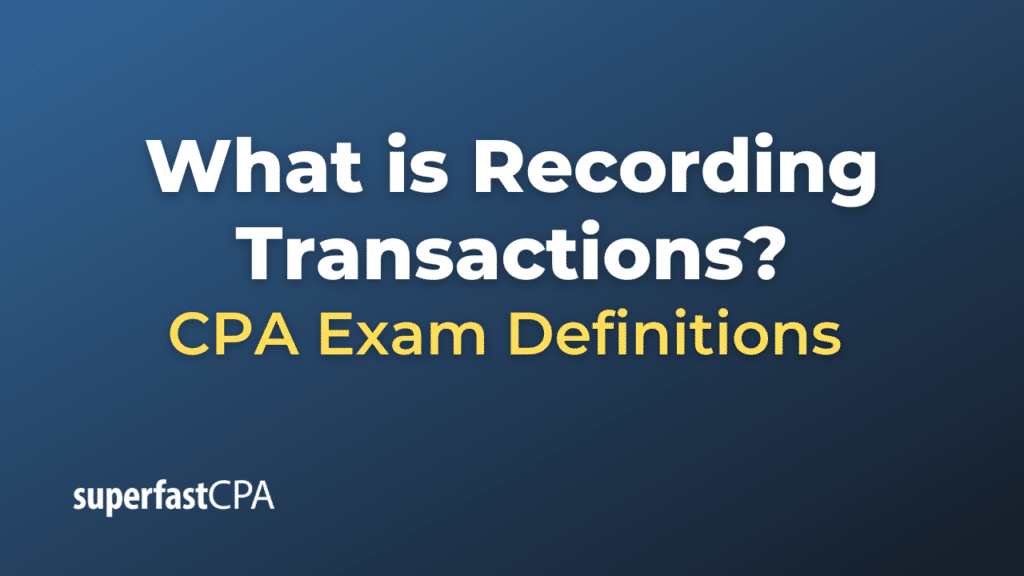Recording Transactions
“Recording transactions” refers to the process of documenting business and financial activities in the accounting system of an organization. Every financial activity, such as sales, purchases, borrowings, payments, etc., needs to be recorded to ensure that the financial statements of the organization accurately reflect its financial position and performance.
The process of recording transactions involves several steps:
- Identification: Recognize a financial transaction has occurred. This could be the receipt of an invoice, the making of a sale, the receipt of cash, etc.
- Classification: Determine what type of transaction it is. For instance, is it a revenue, expense, asset, liability, or equity transaction?
- Measurement: Assign a monetary value to the transaction. If you sold goods worth $500, then $500 is the measure of that transaction.
- Journal Entry: Record the transaction in a journal. This is the first place where a transaction gets recorded. The journal entry reflects which accounts are impacted and ensures that the accounting equation (Assets = Liabilities + Equity) remains in balance.For example, if you sell a product on credit:
- Debit (increase) Accounts Receivable for $500
- Credit (increase) Sales Revenue for $500
- Ledger Posting : The individual journal entries are then posted to the general ledger, which contains all of the accounts of an organization. Over time, the ledger accounts will provide the balances and details of all financial transactions related to a specific account, like “Cash” or “Accounts Receivable.
- Trial Balance: After a certain period (like a month or quarter), accountants will prepare a trial balance to ensure that total debits equal total credits across all accounts. This step is a check on the accuracy of the journal entries.
- Financial Statements: After adjustments, the final balances from the ledgers are used to prepare the main financial statements, such as the Income Statement, Balance Sheet, and Cash Flow Statement.
- Closing: At the end of the accounting period, certain temporary accounts (like revenues and expenses) are closed to prepare the books for the next period.
It’s crucial for organizations to record transactions accurately and promptly. This ensures that the financial statements are correct, which is vital for internal decision-making, regulatory compliance, and the trust of external stakeholders like investors, creditors, and others. Modern organizations often use accounting software to assist in recording transactions, which can automate many aspects of the process and reduce the risk of errors.
Example of Recording Transactions
Let’s walk through a simple example involving the purchase of office supplies on credit.
Imagine you run a small business called “Tech Haven.” On August 1, 2023, you purchase $200 worth of office supplies from “OfficeWorld Supplies,” and you agree to pay them later (on credit).
Recording the Transaction:
- Identification:
- You receive an invoice from “OfficeWorld Supplies” for the office supplies.
- Classification:
- The transaction involves an expense (office supplies) and a liability (amount you owe).
- Measurement:
- The total value of the transaction is $200.
- Journal Entry:
- In your journal, you’d record:
- Debit (increase) Office Supplies Expense: $200
- Credit (increase) Accounts Payable: $200
- In your journal, you’d record:
- Ledger Posting:
- The $200 debit would be posted to the Office Supplies Expense account in the general ledger.
- The $200 credit would be posted to the Accounts Payable account in the general ledger.
- Trial Balance (at month-end or quarter-end):
- When preparing the trial balance, the balances from all ledger accounts, including Office Supplies Expense and Accounts Payable, would be listed to ensure that total debits equal total credits.
Now, let’s say on August 20, 2023, you pay off the $200 you owe to “OfficeWorld Supplies.”
Recording the Payment:
- Identification:
- You make a payment, evidenced by a bank transaction or a check.
- Classification:
- This involves a decrease in liabilities (you’re reducing the amount you owe) and a decrease in assets (you’re using cash to make the payment).
- Measurement:
- The payment amount is $200.
- Journal Entry:
- You’d record:
- Debit (decrease) Accounts Payable: $200
- Credit (decrease) Cash: $200
- You’d record:
- Ledger Posting:
- The $200 debit is posted to the Accounts Payable account, decreasing its balance.
- The $200 credit is posted to the Cash account, decreasing its balance.
By consistently recording transactions in this manner, “Tech Haven” can keep track of its financial activities and ensure its financial statements are accurate.













